fuel additives MERCEDES-BENZ GLA 2016 Owners Manual
[x] Cancel search | Manufacturer: MERCEDES-BENZ, Model Year: 2016, Model line: GLA, Model: MERCEDES-BENZ GLA 2016Pages: 390, PDF Size: 10.2 MB
Page 12 of 390
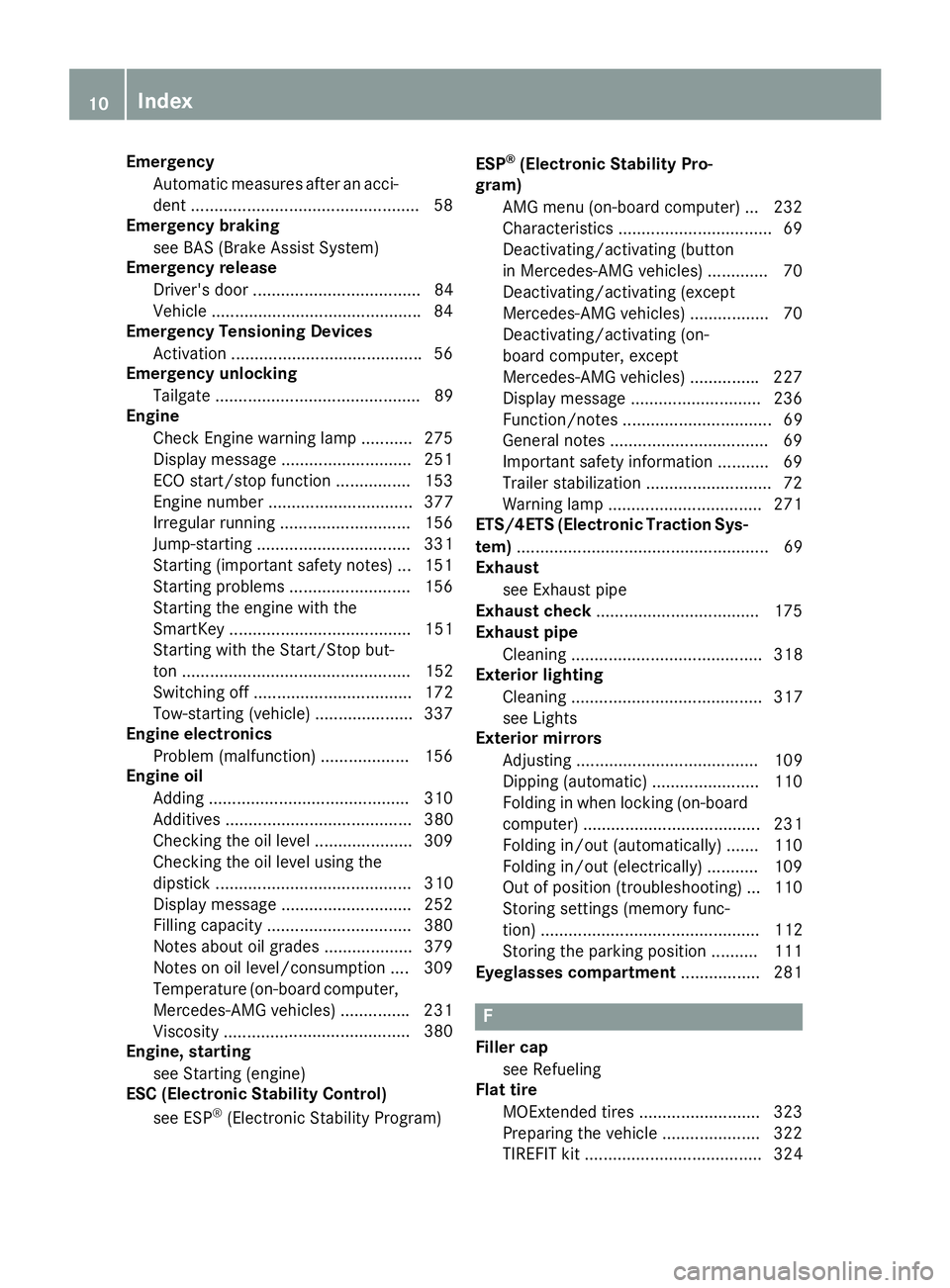
Emergency
Automatic measures after an acci-
dent ................................................ .5 8
Emergency braking
see BAS (Brake Assist System)
Emergency release
Driver's door .................................... 84
Vehicle ............................................ .8 4
Emergency Tensioning Devices
Activation ........................................ .5 6
Emergency unlocking
Tailgate ............................................ 89
Engine
Check Engine warning lamp .......... .2 75
Display message ............................ 251
ECO start/stop function ................ 153
Engine number ............................... 377
Irregular running ............................ 156
Jump-starting ................................. 331
Starting (important safety notes) ... 151
Starting problems .......................... 156
Starting the engine with the
SmartKey ....................................... 151
Starting with the Start/Stop but-
ton ................................................. 152
Switching off .................................. 172
Tow-starting (vehicle) ..................... 337
Engine electronics
Problem (malfunction) ................... 156
Engine oil
Adding .......................................... .3 10
Additives ........................................ 380
Checking the oil level ..................... 309
Checking the oil level using the
dipstick .......................................... 310
Display message ............................ 252
Filling capacity ............................... 380
Notes about oil grades ................... 379
Notes on oil level/consumption .... 309
Temperature (on-board computer,
Mercedes-AMG vehicles) .............. .2 31
Viscosity .............. .......................... 380
E ng
ine, starting
see Starting (engine)
ESC (Electronic Stability Control)
see ESP ®
(Electronic Stability Program) ESP ®
(Electronic Stability Pro-
gram)
AMG menu (on-board computer) ... 232
Characteristics ................................. 69
Deactivating/activating (button
in Mercedes-AMG vehicles) ............. 70
Deactivating/activating (except
Mercedes ‑ AMG vehicles) ................. 70
Deactivating/activating (on-
board computer, except
Mercedes-AMG vehicles) .............. .2 27
Display message ............................ 236
Function/notes ................................ 69
General notes .................................. 69
Important safety information ........... 69
Trailer stabilization ........................... 72
Warning lamp ................................. 271
ETS/4ETS (Electronic Traction Sys-
tem) ...................................................... 69
Exhaust
see Exhaust pipe
Exhaust check ................................... 175
Exhaust pipe
Cleaning ......................................... 318
Exterior lighting
Cleaning ......................................... 317
see Lights
Exterior mirrors
Adjusting ....................................... 109
Dipping (automatic) ....................... 110
Folding in when locking (on-board
computer) ...................................... 231
Folding in/out (automatically) ....... 110
Folding in/out (electrically) ........... 109
Out of position (troubleshooting) ... 110
Storing settings (memory func-
tion) ............................................... 112
Storing the parking position .......... 111
Eyeglasses compartment ................. 281
F
Filler cap
see Refueling
Flat tire
MOExtended tires .......................... 323
Preparing the vehicle ..................... 322
TIREFIT kit ...................................... 32410
Index
Page 13 of 390
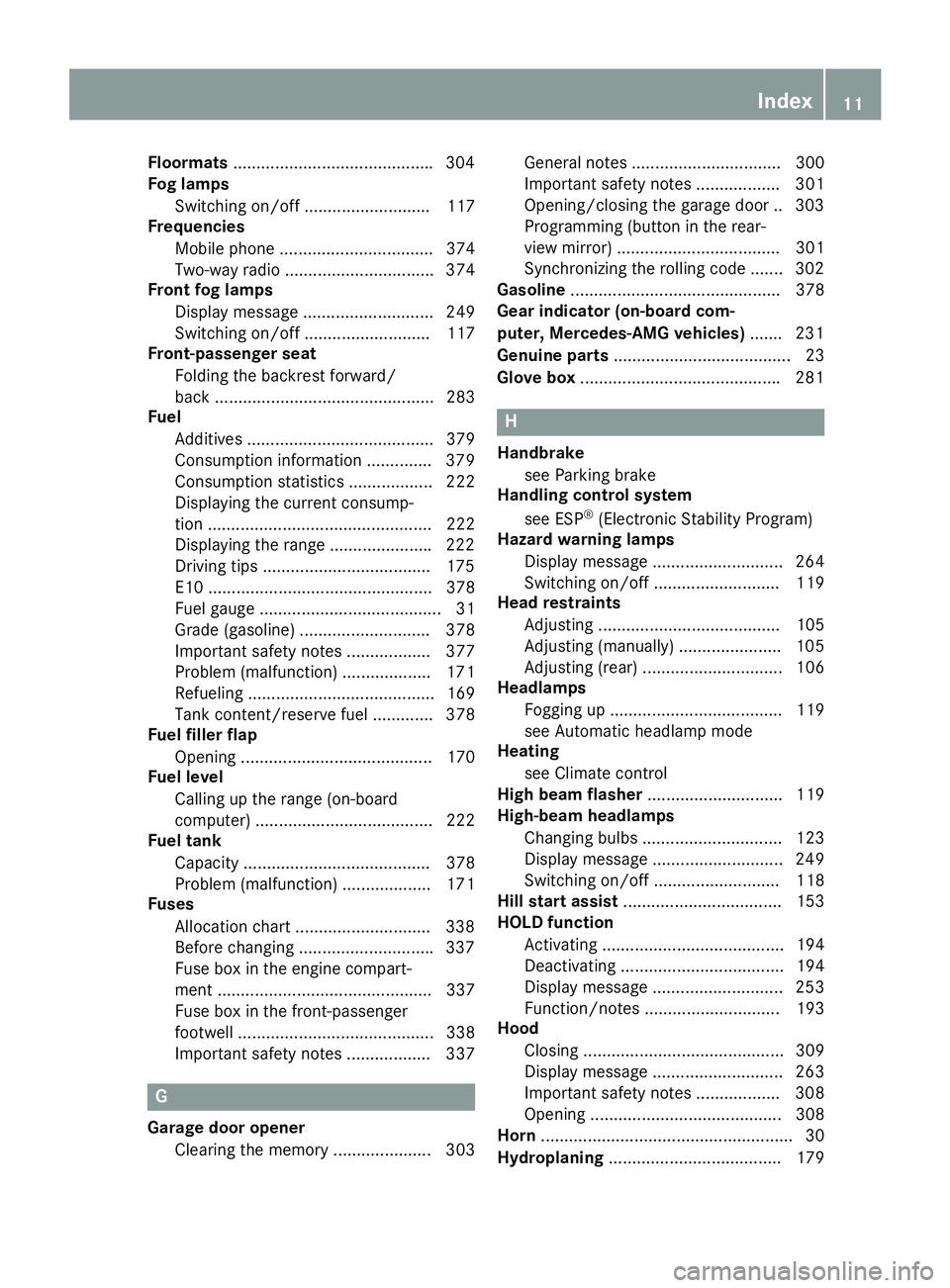
Floormats .......................................... .3 04
Fog lamps
Switching on/off ........................... 117
Frequencies
Mobile phone ................................. 374
Two-way radio ................................ 374
Front fog lamps
Display message ............................ 249
Switching on/off ........................... 117
Front-passenger seat
Folding the backrest forward/
back ............................................... 283
Fuel
Additives ........................................ 379
Consumption information .............. 379
Consumption statistics .................. 222
Displaying the current consump-
tion ................................................ 222
Displaying the range ..................... .2 22
Driving tips ................................... .1 75
E10 ................................................ 378
Fuel gauge ....................................... 31
Grade (gasoline) ............................ 378
Important safety notes .................. 377
Problem (malfunction) ................... 171
Refueling ........................................ 169
Tank content/reserve fuel ............. 378
Fuel filler flap
Opening ......................................... 170
Fuel level
Calling up the range (on-board
computer) ...................................... 222
Fuel tank
Capacity ........................................ 378
Problem (malfunction) ................... 171
Fuses
Allocation chart ............................ .3 38
Before changing ............................ .3 37
Fuse box in the engine compart-
ment .............................................. 337
Fuse box in the front-passenger
footwell .......................................... 338
Important safety notes .................. 337
G
Garage door opener
Clearing the memory ..................... 303 General notes ................................ 300
Important safety notes .................. 301
Opening/closing the garage door .. 303
Programming (button in the rear-
view mirror) ................................... 301
Synchronizing the rolling code ....... 302
Gasoline ............................................. 378
Gear indicator (on-board com-
puter, Mercedes-AMG vehicles) ....... 231
Genuine parts ...................................... 23
Glove box .......................................... .2 81
H Handbrake
see Parking brake
Handling control system
see ESP ®
(Electronic Stability Program)
Hazard warning lamps
Display message ............................ 264
Switching on/off ........................... 119
Head restraints
Adjusting ....................................... 105
Adjusting (manually) ...................... 105
Adjusting (rear) .............................. 106
Headlamps
Fogging up ..................................... 119
see Automatic headlamp mode
Heating
see Climate control
High beam flasher ............................. 119
High-beam headlamps
Changing bulbs .............................. 123
Display message ............................ 249
Switching on/off ........................... 118
Hill start assist .................................. 153
HOLD function
Activating ....................................... 194
Deactivating ................................... 194
Display message ............................ 253
Function/notes ............................. 193
Hood
Closing ........................................... 309
Display message ............................ 263
Important safety notes .................. 308
Opening ......................................... 308
Horn ...................................................... 30
Hydroplaning ..................................... 179Index 11
Page 380 of 390
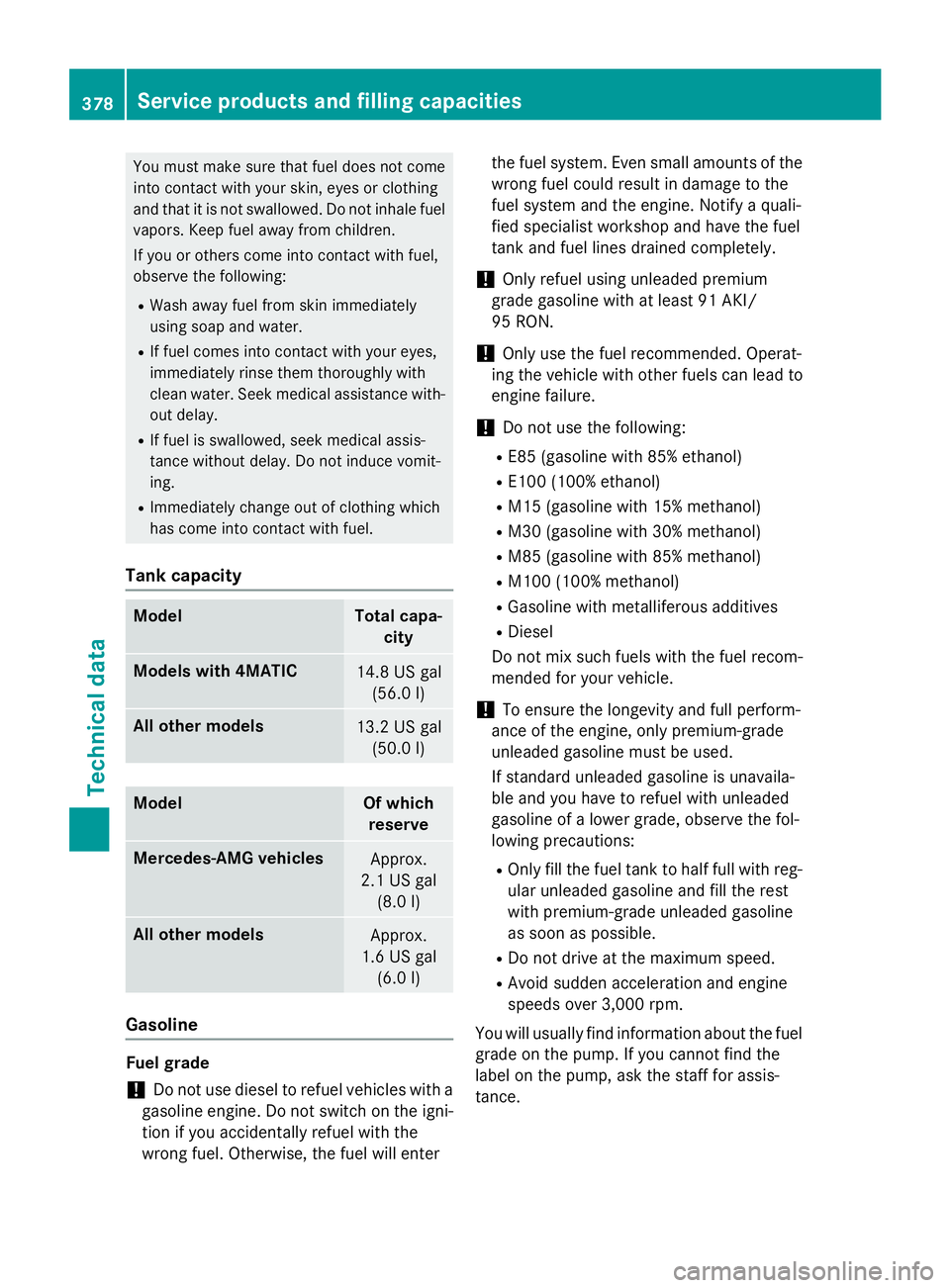
You must make sure that fuel does not come
into contact with your skin, eyes or clothing
and that it is not swallowed. Do not inhale fuel
vapors. Keep fuel away from children.
If you or others come into contact with fuel,
observe the following: R
Wash away fuel from skin immediately
using soap and water. R
If fuel comes into contact with your eyes,
immediately rinse them thoroughly with
clean water. Seek medical assistance with-
out delay. R
If fuel is swallowed, seek medical assis-
tance without delay. Do not induce vomit-
ing. R
Immediately change out of clothing which
has come into contact with fuel.
Tank capacity
Model Total capa-
city
Models with 4MATIC
14.8 US gal
(56.0 l)
All other models
13.2 US gal
(50.0 l)
Model Of which
reserve
Mercedes ‑ AMG vehicles
Approx.
2.1 US gal
(8.0 l)
All other models
Approx.
1.6 US gal
(6.0 l)
Gasoline
Fuel grade
! Do not use diesel to refuel vehicles with a
gasoline engine. Do not switch on the igni-
tion if you accidentally refuel with the
wrong fuel. Otherwise, the fuel will enter the fuel system. Even small amounts of the
wrong fuel could result in damage to the
fuel system and the engine. Notify a quali-
fied specialist workshop and have the fuel
tank and fuel lines drained completely.
! Only refuel using unleaded premium
grade gasoline with at least 91 AK I/
95 RON.
! Only use the fuel recommended. Operat-
ing the vehicle with other fuels can lead to
engine failure.
! Do not use the following: R
E85 (gasoline with 85% ethanol) R
E100 (100% ethanol) R
M15 (gasoline with 15% methanol) R
M30 (gasoline with 30% methanol) R
M85 (gasoline with 85% methanol) R
M100 (1 00% methanol) R
Gasoline with metalliferous additives R
Diesel
Do not mix such fuels with the fuel recom-
mended for your vehicle.
! To ensure the longevity and full perform-
ance of the engine, only premium-grade
unleaded gasoline must be used.
If standard unleaded gasoline is unavaila-
ble and you have to refuel with unleaded
gasoline of a lower grade, observe the fol-
lowing precautions: R
Only fill the fuel tank to half full with reg-
ular unleaded gasoline and fill the rest
with premium-grade unleaded gasoline
as soon as possible. R
Do not drive at the maximum speed. R
Avoid sudden acceleration and engine
speeds over 3,000 rpm.
You will usually find information about the fuel
grade on the pump. If you cannot find the
label on the pump, ask the sta ff for assis-
ta nce.378
Service products and filling capacities
Technical data
Page 381 of 390
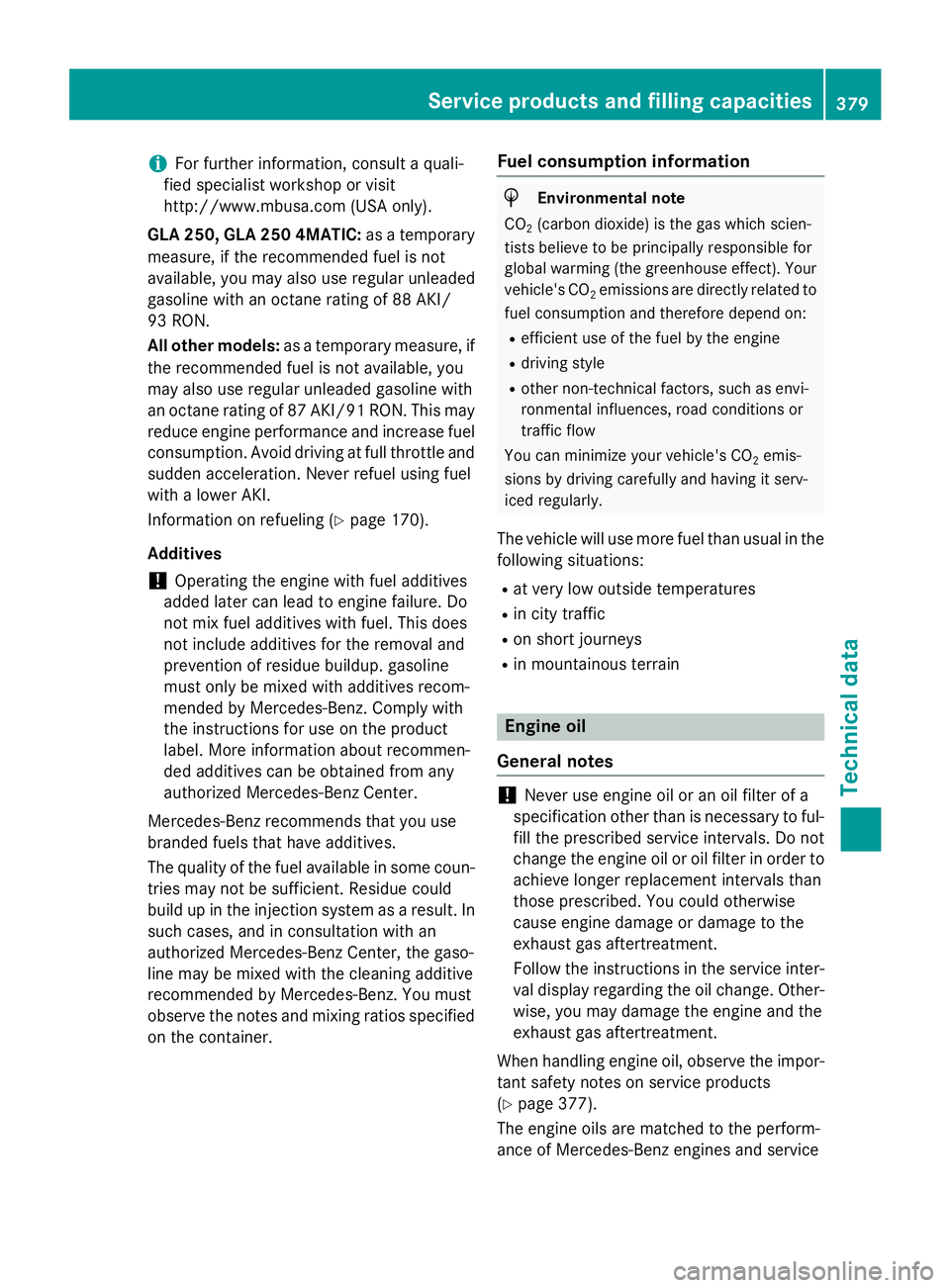
i For further information, consult a quali-
fied specialist workshop or visit
http://www.mbusa.com (U SA only).
GLA 250, GLA 250 4MATIC: as a temporary
measure, if the recommended fuel is not
available, you may also use regular unleaded
gasoline with an octane rating of 88 AKI/
93 RON.
All other models: as a temporary measure, if
the recommended fuel is not available, you
may also use regular unleaded gasoline with
an octane rating of 87 AKI/91 RON. This may
reduce engine performance and increase fuel
consumption. Avoid driving at full throttle and
sudden acceleration. Never refuel using fuel
with a lower AKI.
Information on refueling ( Y
page 170).
Additives
! Operating the engine with fuel additives
added later can lead to engine failure. Do
not mix fuel additives with fuel. This does
not include additives for the removal and
prevention of residue buildup. gasoline
must only be mixed with additives recom-
mended by Mercedes-Benz. Comply with
the instructions for use on the product
label. More information about recommen-
ded additives can be obtained from any
authorized Mercedes-Benz Center.
Mercedes-Benz recommends that you use
branded fuels that have additives.
The quality of the fu el available in some coun-
tri
es may not be sufficient. Residue could
build up in the injection system as a result. In
such cases, and in consultation with an
authorized Mercedes-Benz Center, the gaso-
line may be mixed with the cleaning additive
recommended by Mercedes-Benz. You must
observe the notes and mixing ratios specified
on the container. Fuel consumption information
H Environmental note
CO 2
(carbon dioxide) is the gas which scien-
tists believe to be principally responsible for
global warming (the greenhouse effect). Your
vehicle's CO 2
emissions are directly related to
fuel consumption and therefore depend on: R
efficient use of the fuel by the engine R
driving style R
other non-technical factors, such as envi-
ronmental influences, road conditions or
traffic flow
You can minimize your vehicle's CO 2
emis-
sions by driving carefully and having it serv-
iced regularly.
The vehicle will use more fuel than usual in the
following situations: R
at very low outside temperatures R
in city traffic R
on short journeys R
in mountainous terrain
Engine oil
General notes
! Never use engine oil or an oil filter of a
specification other than is necessary to ful-
fill the prescribed service intervals. Do not
change the engine oil or oil filter in order to
achieve longer replacement intervals than
those prescribed. You could otherwise
cause engine damage or damage to the
exhaust gas aftertreatment.
Follow the instructions in the service inter-
val display regarding the oil change. Other-
wise, you may damage the engine and the
exhaust gas aftertreatment.
When handling engine oil, observe the impor-
tant safety notes on service products
( Y
page 377).
The engine oils are matched to the perform-
ance of Mercedes-Benz engines and serviceService products and filling capacities 379
Technical data Z
Page 382 of 390
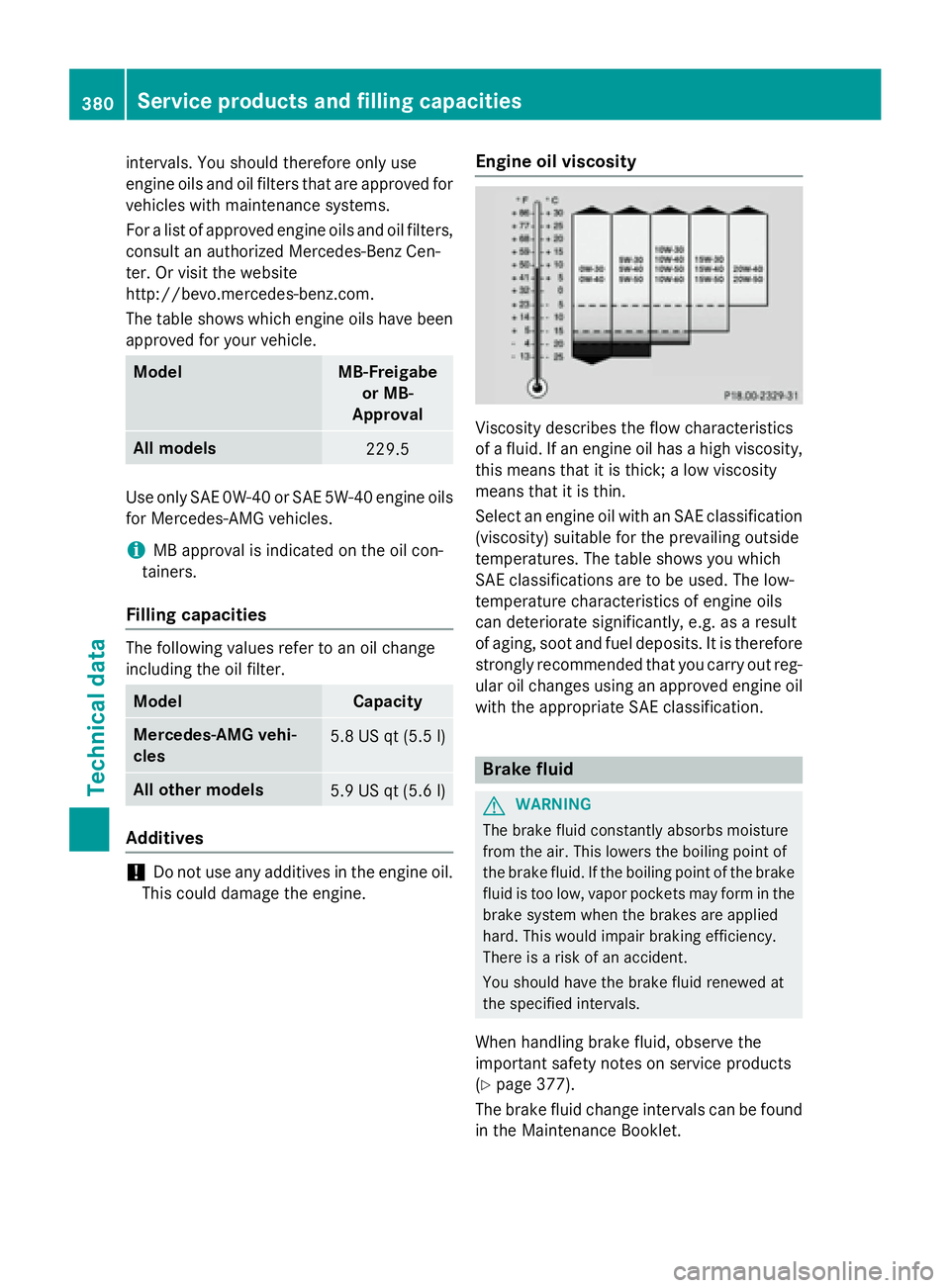
intervals. You should therefore only use
engine oils and oil filters that are approved for
vehicles with maintenance systems.
For a list of approved engine oils and oil filters,
consult an authorized Mercedes-Benz Cen-
ter. Or visit the website
http://bevo.mercedes-benz.com.
The table shows which engine oils have been
approved for your vehicle.
Model MB-Freigabe
or MB-
Approval
All models
229.5
Use only SAE 0W-40 or SAE 5W-40 engine oils
for Mercedes-AMG vehicles.
i MB approval is indicated on the oil con-
tainers.
Filling capacities The following values refer to an oil change
including the oil filter.
Model Capacity
Mercedes ‑ AMG vehi-
cles 5.8 US qt (5.5 l)
All other mod els
5.9 US qt (5.6 l)
Additives
! Do no t use any additive s in th e engin e oil.
This could damag e th e engine. Engine oil viscosity
Visco sity describe s th e flo w characteristics
of a fluid . If an engin e oil has a high viscosity,
this mean s that it is thick ; a low viscosit y
mean s that it is thin.
Selec t an engin e oil wit h an SA E clas sif ication
(viscosity) suitable for th e prevailing outside
temperatures . The table sho ws you whic h
SA E classification s are to be used. The low-
temperature characteristics of engin e oils
can deteriorat e significantly, e.g. as a result
of aging, soo t and fuel depo sits. It is therefor e
strongly recommended that you carry out reg -
ular oil changes usin g an approve d engin e oil
wit h th e appropriat e SA E classification .
Brake fluid
G WARNIN G
The brak e fluid constantl y absorbs moisture
from th e air. This lower s th e boiling poin t of
th e brak e fluid . If th e boiling poin t of th e brak e
fluid is to o low, vapo r pockets may for m in th e
brak e system when th e brakes are applie d
hard. This would impair braking efficiency.
There is a ris k of an accident.
You should hav e th e brak e fluid renewed at
th e specifie d intervals.
When handlin g brak e fluid , observ e th e
important safet y note s on ser vic e products
( Y
page 377).
The brak e fluid chang e intervals can be foun d
in th e Maintenance Booklet .380
Service products and filling capacities
Technical data